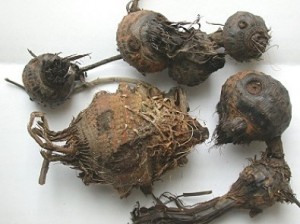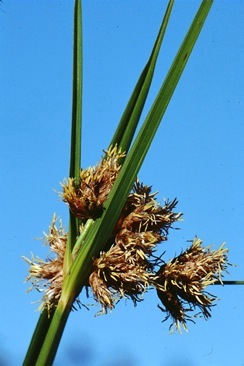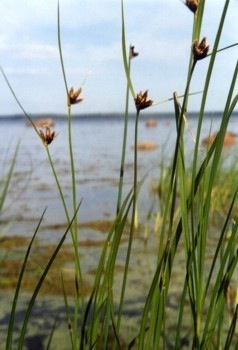Scirpus maritimus: a Tough Root to Crack
If you mention Sea Club Rush among foragers they give you a very blank stare. Understandably so. It was a fall-back staple in Europe that has naturalized itself worldwide and along North American shores from Prince Edward’s Island to Texas, and California north. It’s even managed to make its way up to Arkansas, Kansas, Utah, North Dakota and Saskatchewan so I suspect it is elsewhere as well. It is found in estuaries and salty marshes but can also in fresh water and other damp areas often with cattails.
Most Scirpus tend to be swampy characters with usually soft starchy and sugary roots and stems. (See Bulrush Bonanza elsewhere on site.) Sea Club Rush, Scirpus maritimus (which has many other botanical names as well ) bucks that trend. It can tolerate salty water and has a tough root. The root is quite fibrous and woody and usually requires flaking or grinding to be palatable. This raises issues.
Calories in and calories out is the name of the foraging survival game, today and in the ancient past. So the Sea Club Rush while a fun affectation when foraging is a hobby is another matter if you are surviving off the wilds. In the distant past it had to be a fall back plant because it requires a lot of labor to make it edible. The speculation is other available starchy staples were preferred and the Sea Club Rush was only used when another staple was not available. Here is why.
First you have to collect and trim the roots. Then they have to be pounded to remove the red outer bark. Once cleaned they have to be crushed into flaky bits, or ground into powder. That requires time and considerable energy, and if that is all muscle power, lots of calories. However, once processed they can be used in many ways. I suspect ancient foragers didn’t bother themselves with niceties. You can dehusk it, and grind it and mix with egg to make a tasty damper. But it can also be eaten raw if you have the jaw, teeth, stomach and hunger to do so. Timing would be a key in that when young and small they are tender and have a coconut-like flavor. As they age they become tough. While most focus on the root, the seeds can also be ground into flour. They are the only Scirpus seeds that float.
Scirpus maritimus is found in northern temperate and arctic Europe, England, Ireland, the Channel Islands, north Africa, west Siberia, north west India, Asia, Japan and aforementioned North America. Whether in Australia and New Zealand is a bit of debate. Found in Great Britain it is found in Surrey, Berks, and Middlesex, along the Thames, in Cambridge, Huntingdon, Worcester, Warwick, Stafford, Montgomery, Perth, in the Hebrides, and from Ross and Skye. Scirpus (SKIR-pus) means sharp and maritimus (mare-ree-TEE-mus) in or of the sea.
Green Deane’s “Itemized” Plant Profile
IDENTIFICATION: A three-sided perennial sedge growing to a yard high, hardy to zone 6, Flowers monoecious, either male or female, both sexes can be found on same plant, in dense clusters, seed is three sided, shiny, flattened. Long leaves keeled with channels. Leaves were used for basketry.
TIME OF YEAR: Flowers from spring to summer, seeds ripen summer to fall, but that can vary greatly with climateand salinity. In fact in some places it can flower and grow in winter if the weather and salinity are right.
ENVIRONMENT: Tolerates most soil — likes sand — and can grow in salty areas, cannot grow in the shade, requires moist or wet soil and can grow in water, can tolerate maritime exposure, along the seashore, in shallow tidal rivers, ditches and ponds near the sea, never in the shade. Can be found above the high water mark and on dunes. Roots usually no more than a foot down. Can be found in salty desert watering holes.
METHOD OF PREPARATION: Root (actually tuberous rhizomes) raw or cooked, starchy, usually dried and ground into a powder, roots form tubers at along their length, new plants form at these tubers, young tubers white and starchy, coconut nut flavored, turn brown then black and woody with age. Seeds ground into flour. Young shoots of most Scirpus are edible. Probably all Scirpus roots can be eaten. Known to be edible are the roots of S. acutus, S. paludos, S. fernaldi, and S. robustus. Stems of S. fluviatilis peeled and eaten in Asia, S. lacustris and validus seeds are also eaten.





Hello
I am interested in growing the Sea clab rush in my indoor garden for my leisure research and to later consume. Could you please inform me of any known to you suppliers that I could contact in order to receive/purchase the seeds.
Regards,
Mat
B&T Seeds usually have everything.